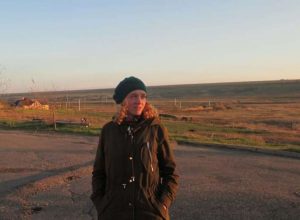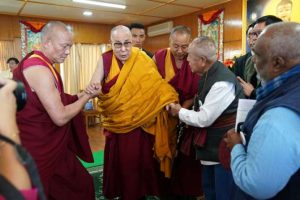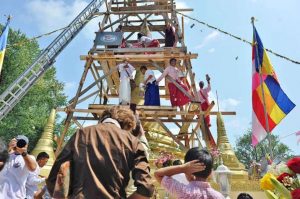
On whichever path you follow—the Mahayana path, and especially the Vajrayana path, which includes visualizations, recitations, and foundation practices—all practices are of course very, very important. But the most important practice of all is the cultivation of compassion. Without compassion, no matter what you do, it will not be the direct cause of enlightenment. For a practice to be a direct cause of enlightenment, you must have enlightenment mind. And to have proper enlightenment mind, you need compassion. Without compassion you can’t have the other qualities. — His Holiness the 41st Sakya Trizin
His Holiness Kyabgon Gongma Trichen Rinpoche, the 41st Sakya Trizin, is one of the most senior lamas in Tibetan Buddhism today—and is considered by many Tibetan Buddhists to be second only to His Holiness the 14th Dalai Lama in terms of the world’s preeminent living masters.
In September, His Holiness made a landmark visit to Nepal, his first in almost a decade,1 where he received a emotional and heartfelt welcome from the nation’s Buddhist community. His Holiness spent almost a month in the Himalayan country, bestowing a series of empowerments, refuge ceremonies, and consecration rituals from 23 September–19 October at numerous monasteries, shrines, and Buddhist institutes.2
Born in Tibet in 1945, His Holiness became the Sakya throne-holder at the age of seven, after he was recognized by His Holiness the 14th Dalai Lama. His Holiness is regarded as an emanation of Manjushri, a yidam and bodhisattva of wisdom. As the 41st Sakya Trizin, the supreme head of the Khon Sakya lineage, founded at Sakya Monastery in Tibet in 1073, he became the longest-reigning Sakya Trizin, holding the office for more than 50 years until 2017.
As a highly revered spiritual leader, His Holiness has founded several major centers of Buddhist learning and monastic practice in India and Nepal, where the scholarship, practices, and traditions of the Sakya school of Tibetan Buddhism are sustained in exile.
A reformed system of throne-holder succession for the lineage was implemented during the 23rd Great Sakya Monlam prayer festival on 11 December 2014. Under the revised system, proposed by His Holiness, members of both the Dolma Phodrang and Phuntsok Phodrang lineages serve as Sakya Trizin for a three-year term, according to their seniority and qualifications, and with the possibility that an office-holder may take office more than once in his lifetime.
Ratna Vajra Rinpoche was enthroned as the 42nd Sakya Trizin on 9 March 2017—the first Sakya Trizin to be enthroned under the new system.3 The current throne-holder is the 43rd Sakya Trizin, Gyana Vajra Rinpoche.
The following interview with His Holiness the 41st Sakya Trizin was conducted at the International Buddhist Academy (IBA), in the Buddhist enclave of Boudha, Kathmandu. The IBA was founded in 2001 by Khenchen Appey Rinpoche (1926–2010) as an educational institute established to uphold and disseminate the Buddhadharma and the teachings of the Sakyapa tradition of Tibetan Buddhism. His Holiness the 41st Sakya Trizin is the spiritual head of the institute.
Due to the time constraints of his official schedule in Nepal and the sheer volume of officials, followers, devotees, and well-wishers waiting to meet His Holiness in person—and due to a series of fortunate events and encounters—this interview with His holiness was conducted in collaboration with Max Dipesh Khatri, a filmmaker and entrepreneur, and project head of the Licchavi House arts project in Kathmandu, and a team from Bodhi Television, a Buddhist television network in Nepal.

Q: Your Holiness, thank you so so much for visiting Nepal. We know you are very busy and that you have your sangha around the world to look after. Despite this, you have blessed us with your visit, and we really want to thank you for that.
His Holiness the 41st Sakya Trizin: I’m also very happy to be in Nepal. It’s a very holy country with many holy places.
Q: Your Holiness, could you talk about your connection and the connection of the Sakya tradition of Tibetan Buddhism with Nepal?
HHST: Broadly speaking, Nepal has a very strong connection with Tibet. When Buddhism first came to Tibet it was with Guru Padmasambhava, Chandrakirti, King Trisong Detsen, and it is said that in their previous lives they prayed when the Boudhanath [stupa in Kathmandu] was being built that they would be able to spread the Buddhadharma in Tibet, the Land of Snows. And then, a Nepalese princess also married with a Tibetan king, and so on—so it’s over a very long time that we’ve had this close connection.
And for myself, before I was born, my father visited Mount Kailash [in Tibet, close to western intersection of the border with India and Nepal], and he also went to Nepal. And it was when he returned from Nepal to Tibet that I was conceived and was born. So even before my birth, I’ve had a connection with Nepal.
Q: Could you tell us about this particular visit? What activities are planned? We know that there are many empowerments that you’re going to bless us with. Is there a specific purpose to your visit this time?
HHST: It has been quite some time since I was last in Nepal, so this time I mainly came for our International Buddhist Academy (IBA). I need to come here from time to time, so mainly I came here for the IBA. And then also because of Ratna Guru-ji,4 he wants me to give a very big initiation . . . and then also, Chandra Sagar Lama, who has created a shrine to Virupa here at the IBA, asked me to consecrate that. So it’s mainly for these three purposes that I have come to Nepal.
Q: Could you talk about the big Avalokiteshvara empowerment that you’re going to bestow for the public? Why is it so important this time?
HHST: Actually, Ratna Guru-ji had asked me to give a Kalachakra empowerment. But the Kalachakra is very big, and I’m now old and I couldn’t do such a big initiation. And, moreover, although I feel that the Kalachakra is very popular, as everybody knows, there are very few people who really practice it. So instead of that, I will give the Avalokiteshvara, who is the karmic lenchak deity of Tibet. Also, among Tibetans and the people of the Himalayan region, Avalokiteshvara is a very important deity. And while they may not be able to do the long practice, everyone can say Om mani padme hum—that, everyone can recite. Therefore, I decided to give the Avalokiteshvara empowerment so that everybody can benefit, and everybody, at least, even if they can’t do long sadanas, can recite the mantra.
Q: Nepal, and specifically the Kathmandu Valley, is also known as the land of Avalokiteshvara because the Newari people have many temples and shrines dedicated to Avalokiteshvara, known here as Karunamaya. Do you see a connection between the empowerments you are giving this time and the local population—the Newars and the people of the Kathmandu Valley?
HHST: Because all of the buddhas are ultimately the same, there’s no difference, but due to our old karmic connections, it makes a difference. So the Tibetans, the Himalayan people, and the Nepalese—especially in Nepal—have a very close karmic connection with Avalokiteshvara, so that’s why I decided to give this initiation.
Q: As you know, young Buddhist people around the world are being diverted or distracted away from the practices and traditions of the Buddhadharma by modern life. How do you think this empowerment can benefit young people? Or how should we reach out to young people with the Dharma or specifically this practice?
HHST: Generally, I’m an optimistic person. I always look at things from a positive point of view. So although now in the modern world there are a lot of distractions [that might make it more difficult] to devote time and energy to practice, at the same time people these days are more intelligent and more steady.
And Buddhism is not a religion that we simply follow as a matter of faith, but by applying reason. More and more people, especially young people who are studying in the universities and colleges, they will . . . not learn in the traditional way, with that kind of blind faith; they will use reason to understand why we practice the Dharma and to understand Buddhist philosophy, so they try to find out more. And as they study more and more, they will find Buddhism to be very relevant to this modern time. So I think that, although for the time being there are a lot of distractions, and that young people may not find it directly . . . eventually, I think people will realize how very important Buddhism is today.

Q: We meet in a time when there is so much suffering in the world, due to environmental catastrophes, due to climate change, due to wars, especially in the last 10–15 years, it seems. What can we as Buddhists do from a practice perspective for a better life and peace in this world?
HHST: I think that so many the problems we face now are due to our own inner defilements, because people have an excess of defilements like anger, jealousy, desire, ignorance, and so on. And so, because of the diseases and wars and all kinds of things that are happening now, what we can do is—of course to pray is important—but the most important thing is to generate loving-kindness and compassion for all sentient beings.
Out of loving-kindness and compassion rises bodhicitta—the enlightenment mind—that rescues all sentient beings from the suffering of samsara and leads them toward enlightenment. So these thoughts, if we as individuals can generate such thoughts, I’m sure that this will be the best antidote to pacify all the problems that we are facing—man-made problems, natural problems, climate change—everything can be pacified.
All Buddhist traditions—especially Tibetan Buddhism, where we have many schools—are basically the same . . . the root of all practice, both Sutrayana and Mantrayana, lies in compassion for all sentient beings; that is our motivation.
Practicing the Dharma is to rescue all sentient beings suffering of samsara.
Q. Your Holiness, looking at the broader acceptance of Himalayan Buddhist traditions around the world, do you see a danger that teachings, traditions, and rituals that have been treasured and preserved for centuries could become diluted and misunderstood?
HHST: As I say, I’m an optimistic person. Of course, there are some problems everywhere— there are always problems. But overall, I think that more people will realize the importance of practicing the Dharma in their daily lives, especially in the West.
Also in the East, many traditional Buddhists just go to temples and light incense and perform circumambulations and prostrations, but don’t think so much about philosophy. But now, with modern education and so on, people are changing. They no longer go straight to the temple without reason; they no longer straight away light incense, but they ask: why should we light the incense? They seek reasons. And this is the whole principle of Mahayana Buddhism, Tibetan Buddhism is to practice with reason and logic—not because this is holy or that’s what the Buddha said; but because this is holy and this is practical because it works like this: when you do that, this comes through logical reasons, which more and more people are realizing thanks to modern education.
So although there are problems, I think eventually the problems will be minimized, and more and more people will come to the Dharma. Even now there are many scientists do not believe in religion, who do not believe in rebirth; the only thing they believe in is what they can see, what they can really touch. Yet many of those same scientists think that Buddhism is relevant, Buddhism is important, Buddhism has something. So, as the whole world [adopts a more scientific mindset], I think more people will realize that Buddhism is relevant during this modern time.

Q. Finally, your Holiness, is there any particular guidance or advice from your own spiritual journey that you would like to share with our readers who are seeking to deepen their own Buddhist practice?
HHST: Yes! What I’d like to say is that as the world is changing now, it’s very important that more people should study—especially those who are followers of the Buddha—they should study the philosophical aspect: what is the Buddhadharma? What is the difference between Buddhism and other religions?
I believe that every religion has its own beauty, its own way to help mankind. So every religion is important to the world. But those of us who are Buddhists, who belong to Buddhism, should focus not only on blind faith, but more on the study of philosophical texts.
Q. Your Holiness, thank you very much for sharing your valuable time.
1 His Holiness the 41st Sakya Trizin previously visited Nepal in December 2015 for the 24th Great Sakya Monlam Prayer Festival, which we held in Lumbini.
2 His Holiness the 41st Sakya Trizin Visits Nepal for the First Time Almost a Decade (BDG)
3 Enthronement of the 42nd Sakya Trizin, His Holiness Ratna Vajra Rinpoche (BDG)
4 Vidyadhar Aacharya Mahayogi Shreedhar Rana Rinpoche, also known as Ratnashree and Ratn Guru-ji, requested that His Holiness come to Nepal.
See more
His Holiness the 41st Sakya Trizin
International Buddhist Academy
Related features from BDG
Community, Calling, and Connection: A Conversation with Dagmo Kalden Dunkyi Sakya
Related news reports from BDG
His Holiness the 41st Sakya Trizin Visits Nepal for the First Time Almost a Decade
Enthronement of the 42nd Sakya Trizin, His Holiness Ratna Vajra Rinpoche
Renowned Sakyapa Teacher His Holiness Dagchen Rinpoche Dies














